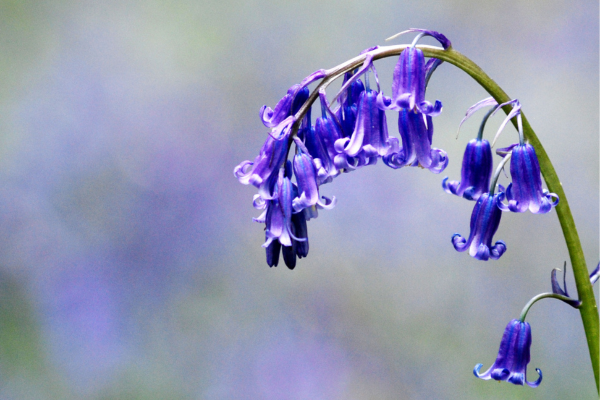
What We've Included
When to Plant | How to Plant | Where to Plant | When to Water | What to do once they have Finished Blooming | Storing Tips | Common Issues & How to Solve Them | When will they Flower?
When to Plant
Bluebells can be planted from March to June or in autumn from September to November for overwintering.

How to Plant
1 – Dig a hole that’s wide enough to fit the bulb comfortably, and at least 2-3 times their depth. If planting in groups, dig a trench instead of individual holes at the same depth.
2 – You can add bonemeal and horticultural grit (or spent compost) to the bottom of the hole. This will help them to grow healthily.
3 – Pop each bulb into the holes, pointed side up. Space them 10-20cm apart.
4 – Cover with soil and pat down.
5 – Cover the soil with bark mulch, like they’d have in a woodland setting.
How to Plant Bluebells in the Green
- Bulbs in the green should be planted in clumps of 3-4 bulbs. Separate them into clumps before planting.
- Plant them up to where the white stops and turns green. This indicates the original planting depth.
- Dig the hole to the same depth and firm them down gently.
- Allow for 6 inches of space between each clump so that they have space to grow and spread.
- Water them once planted, especially if it’s been a bit dry.
- Snip off any flowering stems to help the bulbs concentrate their energy into creating new blooms come the following spring.
Where to Plant
Bluebells love well-drained soil that sits in partial shade. Native species are often found in woodlands, so it’s great if you can replicate these conditions in your garden - by planting them under a tree or shrub for example.
Bluebells are perfect for growing in containers and borders, as well as through grassy areas under trees.

When to Water
Water bluebells well once planted. As they’re growing around spring, they will get sufficient water thanks to the classic British weather! However, if it’s a particularly warm spring, feel free to give them extra water if they’re looking a bit dry.
What to do once they have Finished Blooming
Allow their foliage to die back completely before cutting them back. This allows them to store energy in the bulb, helping to grow a lovely display the following spring.
Storing Tips
There is no need to lift or store bluebells over winter. These are hardy plants, and they need cold conditions to flower in spring. However, if you’re worried or live in a particularly cold part of the country, adding a couple of inches of mulch to the soil can help keep them warm and help them retain moisture over the season.

Common Issues & How to Solve Them
One of the most common issues with bluebells hybridisation, is caused by the imposing new variety – Spanish bluebells. Spanish bluebells are beginning to push out our native species, which could cause them to become extinct.
Spanish bluebells are quite persistent, so it may take several attempts to remove them from your garden. Fork them out of the soil to remove the bulbs, but you may need to repeat this each year.
When will they Flower?
This will depend on the variety you purchase. If you’ve ordered Bluebell bulbs, then you can expect them to flower from March to April. Bluebells in the green, however, are sent to you after they’ve flowered. They will provide colour with their foliage once planted, but it’s doubtful that flowers will appear that same season. You can expect to see them again in early to mid-spring.

